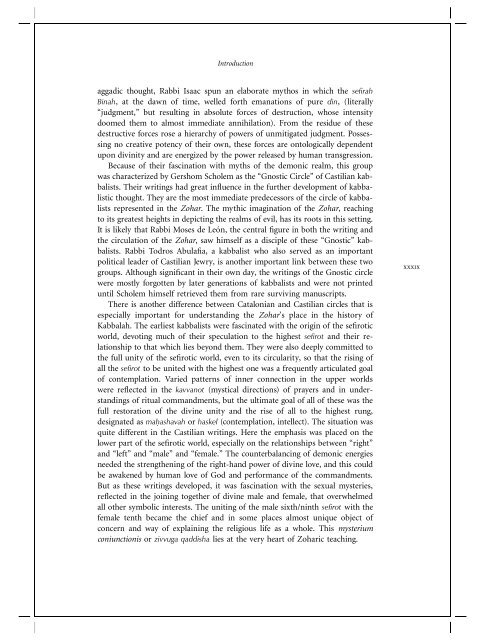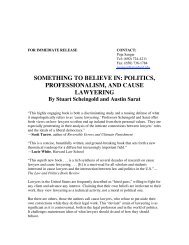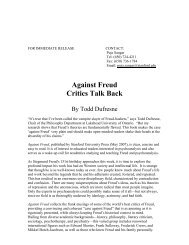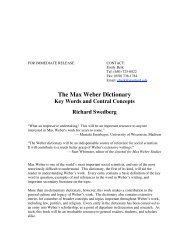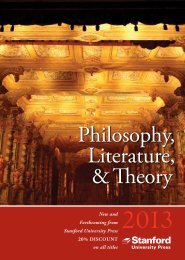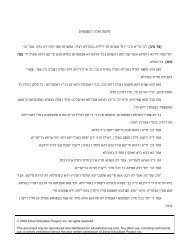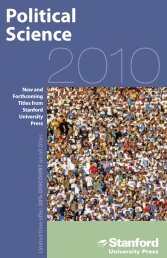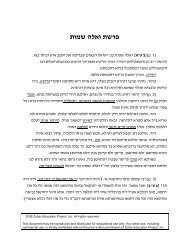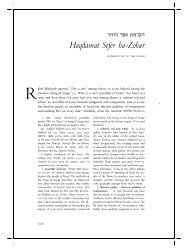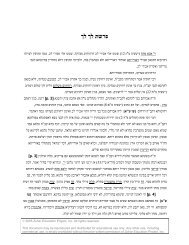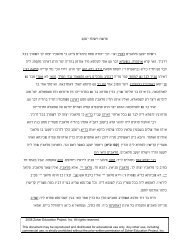Front Matter (PDF) - Stanford University Press
Front Matter (PDF) - Stanford University Press
Front Matter (PDF) - Stanford University Press
Create successful ePaper yourself
Turn your PDF publications into a flip-book with our unique Google optimized e-Paper software.
thought, Rabbi Isaac spun an elaborate mythos in which the se®rah<br />
aggadic<br />
at the dawn of time, welled forth emanations of pure din, (literally<br />
Binah,<br />
but resulting in absolute forces of destruction, whose intensity<br />
``judgment,''<br />
them to almost immediate annihilation). From the residue of these<br />
doomed<br />
forces rose a hierarchy of powers of unmitigated judgment. Possessingno<br />
destructive<br />
creative potency of their own, these forces are ontologically dependent<br />
divinity and are energized by the power released by human transgression.<br />
upon<br />
of their fascination with myths of the demonic realm, this group<br />
Because<br />
characterized by Gershom Scholem as the ``Gnostic Circle'' of Castilian kabbalists.<br />
was<br />
Their writings had great in¯uence in the further development of kabba-<br />
thought. They are the most immediate predecessors of the circle of kabbalistlistic<br />
represented in the Zohar. The mythic imagination of the Zohar, reaching<br />
its greatest heights in depicting the realms of evil, has its roots in this setting.<br />
to<br />
is likely that Rabbi Moses de LeoÂn, the central ®gure in both the writing and<br />
It<br />
circulation of the Zohar, saw himself as a disciple of these ``Gnostic'' kabbalists.<br />
the<br />
Rabbi Todros Abula®a, a kabbalist who also served as an important<br />
leader of Castilian Jewry, is another important link between these two<br />
political<br />
Although signi®cant in their own day, the writings of the Gnostic circle<br />
groups.<br />
mostly forgotten by later generations of kabbalists and were not printed<br />
were<br />
Scholem himself retrieved them from rare survivingmanuscripts.<br />
until<br />
is another difference between Catalonian and Castilian circles that is<br />
There<br />
important for understandingthe Zohar's place in the history of<br />
especially<br />
The earliest kabbalists were fascinated with the origin of the se®rotic<br />
Kabbalah.<br />
devotingmuch of their speculation to the highest se®rot and their re-<br />
world,<br />
to that which lies beyond them. They were also deeply committed to<br />
lationship<br />
full unity of the se®rotic world, even to its circularity, so that the risingof<br />
the<br />
the se®rot to be united with the highest one was a frequently articulated goal<br />
all<br />
contemplation. Varied patterns of inner connection in the upper worlds<br />
of<br />
re¯ected in the kavvanot (mystical directions) of prayers and in understandings<br />
were<br />
of ritual commandments, but the ultimate goal of all of these was the<br />
restoration of the divine unity and the rise of all to the highest rung,<br />
full<br />
as maḥashavah or haskel (contemplation, intellect). The situation was<br />
designated<br />
different in the Castilian writings. Here the emphasis was placed on the<br />
quite<br />
part of the se®rotic world, especially on the relationships between ``right''<br />
lower<br />
``left'' and ``male'' and ``female.'' The counterbalancingof demonic energies<br />
and<br />
the strengthening of the right-hand power of divine love, and this could<br />
needed<br />
awakened by human love of God and performance of the commandments.<br />
be<br />
as these writings developed, it was fascination with the sexual mysteries,<br />
But<br />
in the joiningtogether of divine male and female, that overwhelmed<br />
re¯ected<br />
other symbolic interests. The unitingof the male sixth/ninth se®rot with the<br />
all<br />
tenth became the chief and in some places almost unique object of<br />
female<br />
and way of explainingthe religious life as a whole. This mysterium<br />
concern<br />
Introduction<br />
xxxix<br />
coniunctionis or zivvuga qaddisha lies at the very heart of Zoharic teaching.


